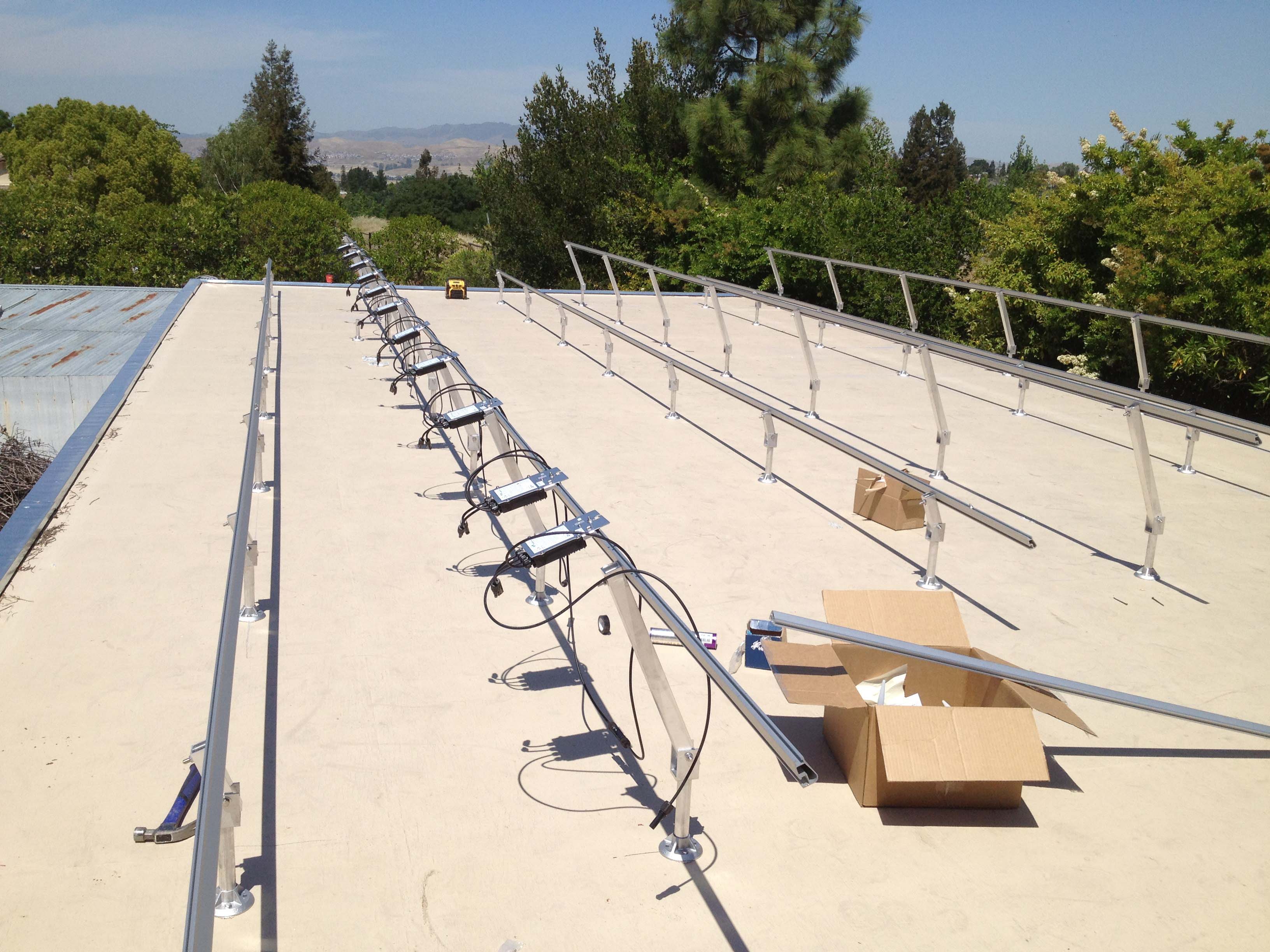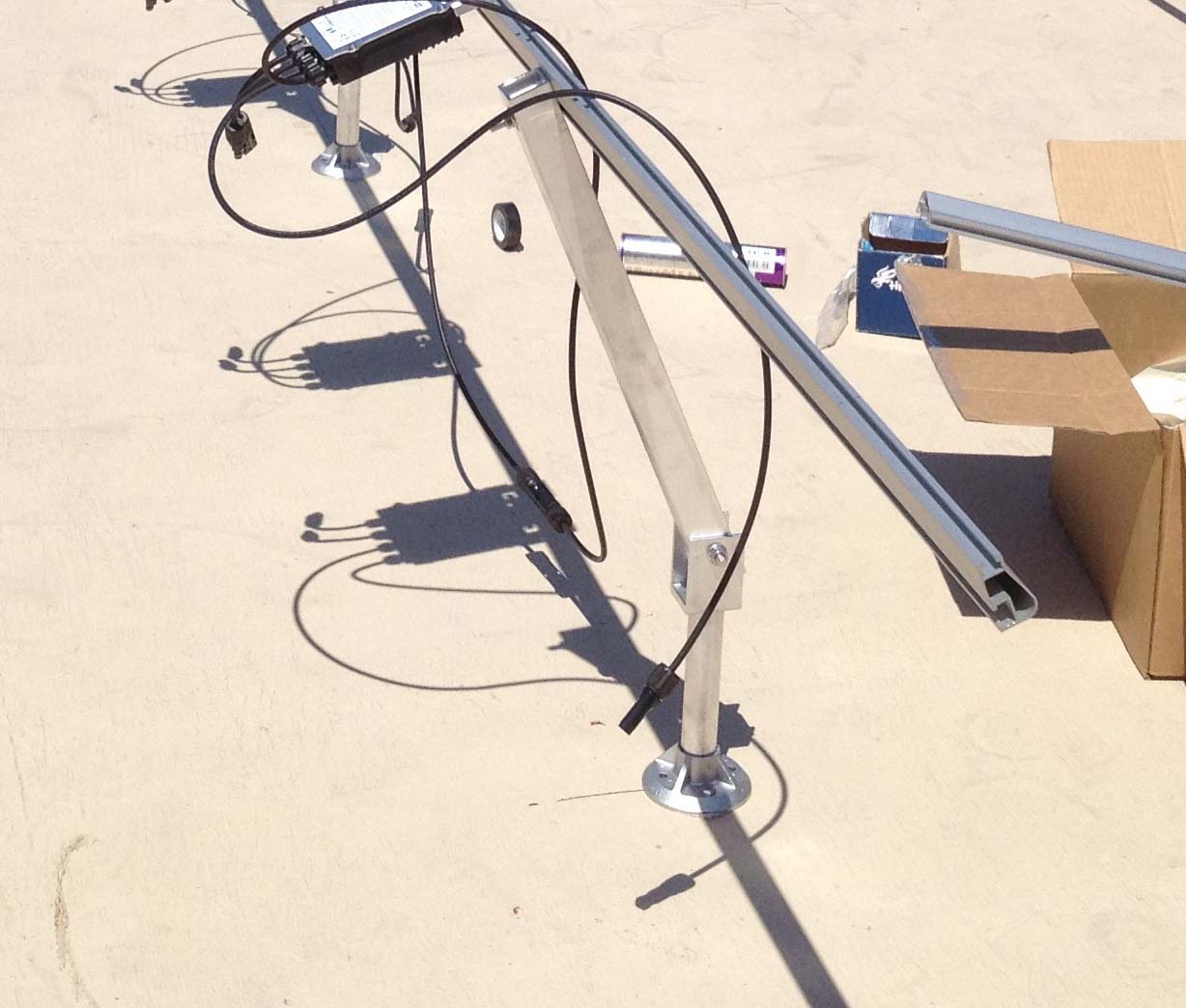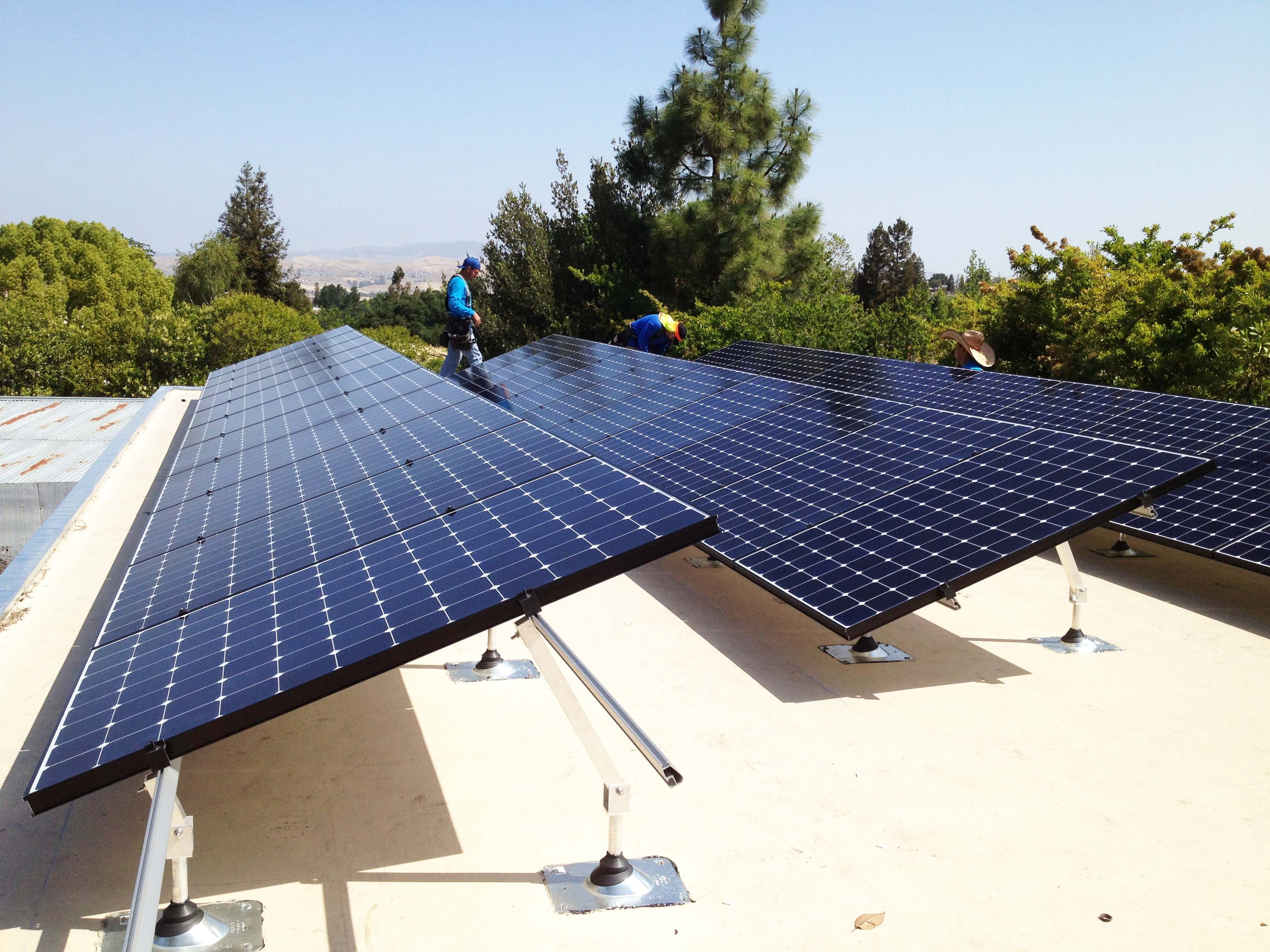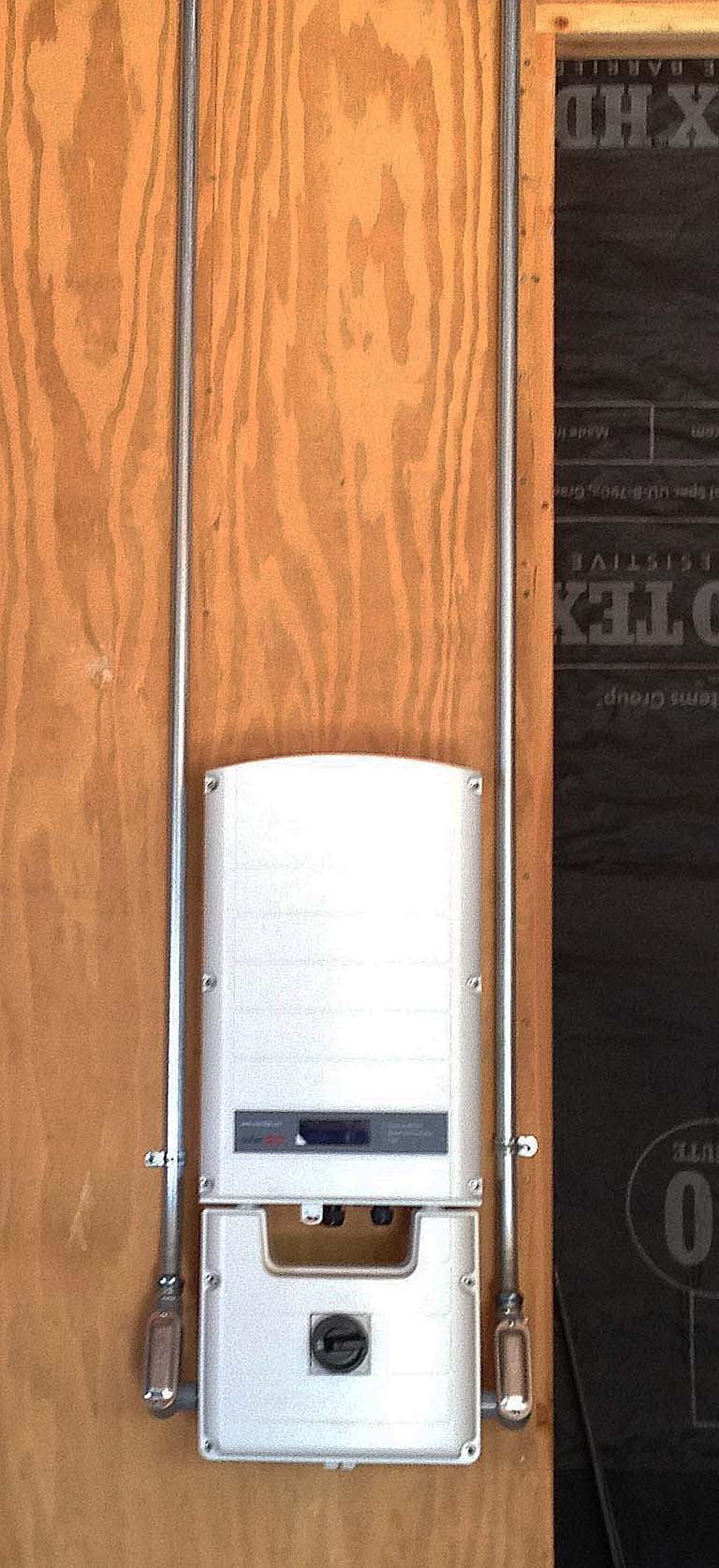|
Solar Project- 2015 |
|
We are having a Photovoltaic Solar System installed on the Carriage House to supply enough electrical power to power the entire home and shop. In essence it will supply the electrical supply that Pacific Gas & Electric now provides. I expect it to provide all that we can use. Our home is completely 100% electric. There is no gas meter on the house. When the home was built in the mid seventies PG&E charged less per KWH (KiloWatt/Hour) as your amount of power used went up. Cheaper by the dozen. At the same time, the pundants all over were telling us that we were running out of Natural Gas, and the price of the gas was going to hit them moon... if we could even get it. So, we went completely electric, and our monthly utility bill was lower than any of the other four homes on the court. PG&E changed their minds and now the more you use, the more you pay for each unit of power, as much as three times the rate when we consume enough electrical power to be in Tier Four. We were always in tier four and seeing electrical monthly bills of $500. With mom staying here they were sky high. So, now we are again reacting to the current situation and producing our own power. The utility company has agreed (was forced) to purchase any excess power we generate (at wholesale rates... about three cents) and charge us for any we need to supplement our system (at full rate, approximately fourteen cents). That allows PG&E, to be the storage facility that gives back when the sun is down or it is overcast. We have chosen to have Your Energy Systems - YES - to do the work. The did our neighbor's work three years ago. We recommended them to our nephew Ed an Andi in Livermore for their system, and we recommended them to do our son Kent and Linda's system. |
|
October... We have called Jim with Your Energy Solutions... YES... to come over and measure up the roof of the Carriage House for a solar photovoltaic (PV) system to provide our electrical power for the whole property. It should do the same as the system Jim placed on the neighbor's roof (Lee & Judy) , and Lee has not paid a PG&E bill for two years... except for about five dollars a month for their bookwork. I will include images of the system and keep you up to date on how that goes. They do not expect to do the installation until January, due to their being so busy. City will inspect the solar installation and then I should be off their radar for a while. That will allow me to do more work on the building to make it look a little more like a Carriage House instead of a shoe box. I cannot wait for that. 11/11/14 - Jeff from Your Energy Solutions came today and looked at the electrical layout of this property, so they can come up with a plan to add the solar array into the PG&E network. Basically, the array on the roof of the Carriage House will produce anything from zero to more than 7 kWh of power, depending upon the amount of sunlight hitting the panels. School time: The amount of power an electrical device uses is measured with a meter and is reported in WATTS (kW). A small living room light bulb may use 60 watts. The power you use in your home is measured in Kilowatt-hours, with the symbol kWh. One kWh is 1,000 watts flowing for a full hour. Our home used 13,500 kWh last year, as per PG&E reports. When we pay our PG&E power bill, they bill us for a number of kWh used, as per the meter on the side of the house.
03/31/15 - We are in Hawai'i doing our annual house-sitting gig. We finally have some bids and a contract for the solar project. Jim offered four choices. All systems were between a 9.25 kWh system and a 10.125 kWh system. We chose the largest system. Thirty-one 327 watt panels, an inverter inside the building, individual "optimizers" under each panel, and the necessary wiring to bring it all online. This system does not use the individual mini-inverters at each panel that converts the DC electrical production of each panel into AC power. Instead it uses "optimizer" units to control the panel at the panel, and then an inverter to convert the generated DC power to AC power. When the system uses a central inverter, the inverter is usually warranted ten years and seldom lasts longer than that. This system however puts the controller part at the panels, and the inverter is warranted for 25 years. We are looking at a $45,000 cost, with a $13,500 tax credit, making the net cost $31,500. We calculate that the system will provide our entire power requirement which will pay back as much as the system cost in about 8 1/4 years. After that, power is free. Yeah! This system should generate around 16,500 kWh over the full year. We signed the contract via internet. April fifth was predicted as the start of construction, after our return from Hawai'i.. 05/01/15 - The first day of work. It appears that some of the delay was that the contractor was not that familiar with my roofing on the deck of the Carriage House. It is an elastomeric coating that is rolled on (GecoDeck), allowing me to 'renew' the roof surface at will. They wanted to install a new roof... over my brand new roof. I explained how it worked and told them that I would stand behind the roof leaks. That pleased them. Also, the panel array stands on supports that attach to the deck, with large lag bolts, which normally screw into the rafters. My rafters are Trus-Joists which are more delicate than 2" thick rafters, and can be compromised by their bolts. So I designed a blocking system that basically placed four inches of stock directly under the plywood decking, and I agreed to install them, as soon as they could tell me where they wanted them to be. |
|
|
|
The rails are installed. Three rows of panels, will be placed on the rails, facing to the left in this image (West). The little boxes on the upper rail of the first row of panels are the optimizers, one per panel, and they allow each of the 31 panels to be monitored on software that will indicate their individual performance. To attach the supports for the panels I was placing the braces under the roof while the crew installed the rails. They expect to finish this up next week and install the solar panels. |
|
|
|
When the blocking was all installed, I went topside to see how the crew were doing. Can you see anything that is missing? The supports are lag-screwed to the deck. Can we see any location that might leak water in the rain? There are fifty-two of those locations. The flange on the deck with the round six-inch tall standard coming up from the center should not be visible. They should be hidden by a roof jack, a little tin tent with a neoprene seal around the round support, that will enclose them and guard from the water that will be on the deck. We even discussed it earlier in the day, because they had to have my braces in place to allow them to install the roof jack before anything went on top of that six inch support. Oops. So how do they correct their error? The squared metal part on the top of the short round support will have to be unbolted from the support so the roof jack can be installed over the support, reverse that process to return the structure to the support... and then repeat it for the other 51 supports. Man, guys... were you asleep? The workers blamed someone else for not putting the roof jacks on their truck. Well, they should have gone and picked them up because it will be a good four man-hour mistake. I required the panels to be at least six inches off the deck so I can roll on a new coat of the roof when needed. I will do two coats when the solar work is done... to seal the... um... roof jacks from the rain. The panels will sit at a 15° slope. This support in the image will support the higher end of the panels. |
|
|
|
The panels are installed and the system is complete. Note that roof jacks have been installed on the support posts. It was reveled that the installation company was concerned about the supports leaking because I had indicated that I would seal the supports by painting them with the elastomeric coating that is on the roof. That was a major reason for the delay of installation of the system. If fault were to be assigned, it was the lack of face-to-face agreement on the installation process. I appreciate Your Energy Solutions for rectifying the error. Each of these thirty-one panels will generate up to about 65 volts, Direct Current. Combined, they send around 375 volts DC to the inverter inside the building, which inverts it to about 243 volts AC for our use. |
|
|
|
The power from the panels comes into the building and into this unit, the Inverter. Here the power is inverted from Direct Current to Alternating Current, and reduced in voltage to 243 volts. From here it enters a standard distribution panel that contains a 40 amp breaker for this system and other breakers that will feed circuits in the shop. The panel holds a main breaker that will be connected into the home's system and the utility system's power meter. The system awaits inspection by the city and then by the utility company, and then they can turn that big rotary switch to connect the system. Before they go 'on-line', they will have to have replaced our current electric power meter with a "solar" power meter that is capable of measuring power both entering the facility from the utility and measuring the solar power generated at the facility that will go back out to the utility company. |
|
When the system is complete, it can basically be turned on and used. But PG&E wants it left off until they can bless it with a "Permission To Operate" or PTO. That is necessary for two reasons: If a lineman works on the power line in the street, he needs a computer printout that tells him where the power will be coming from. It no longer only comes from the big dam in the mountains or coal-burning power plant or whatever... it now can be coming from any of the homes that are on the 'receiving' end of the power lines. Not knowing that, and not taking every precaution, a lineman can be in real trouble, so to avoid that we need to have that PTO. The other reason we need that is that it tells us that the utility's computer now knows that a reverse flow or negative number at my house is OK. And they can start billing us accordingly. That reverse flow will now be credited to my bill instead of the other way around. Until we got that straight, the solar system at our home was functioning and sending power out to the utility for about 8 hours, and after powering our home it sent out an extra 39 kWh. The highest rate of power going out to the grid was 7.5 kW at around 2 pm. The house was using probably around 1.5 kW at that time. |
|
|
|
T |



